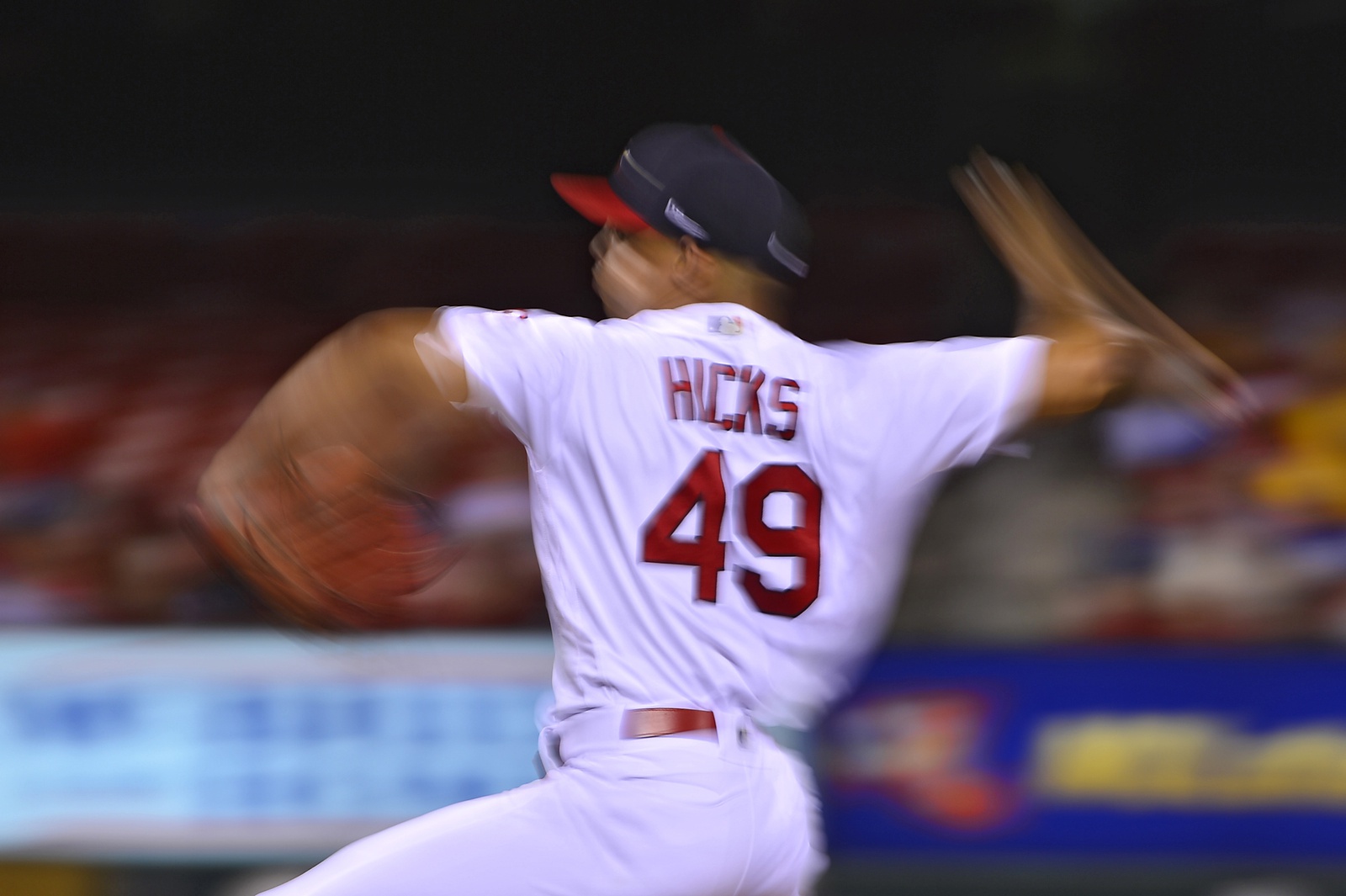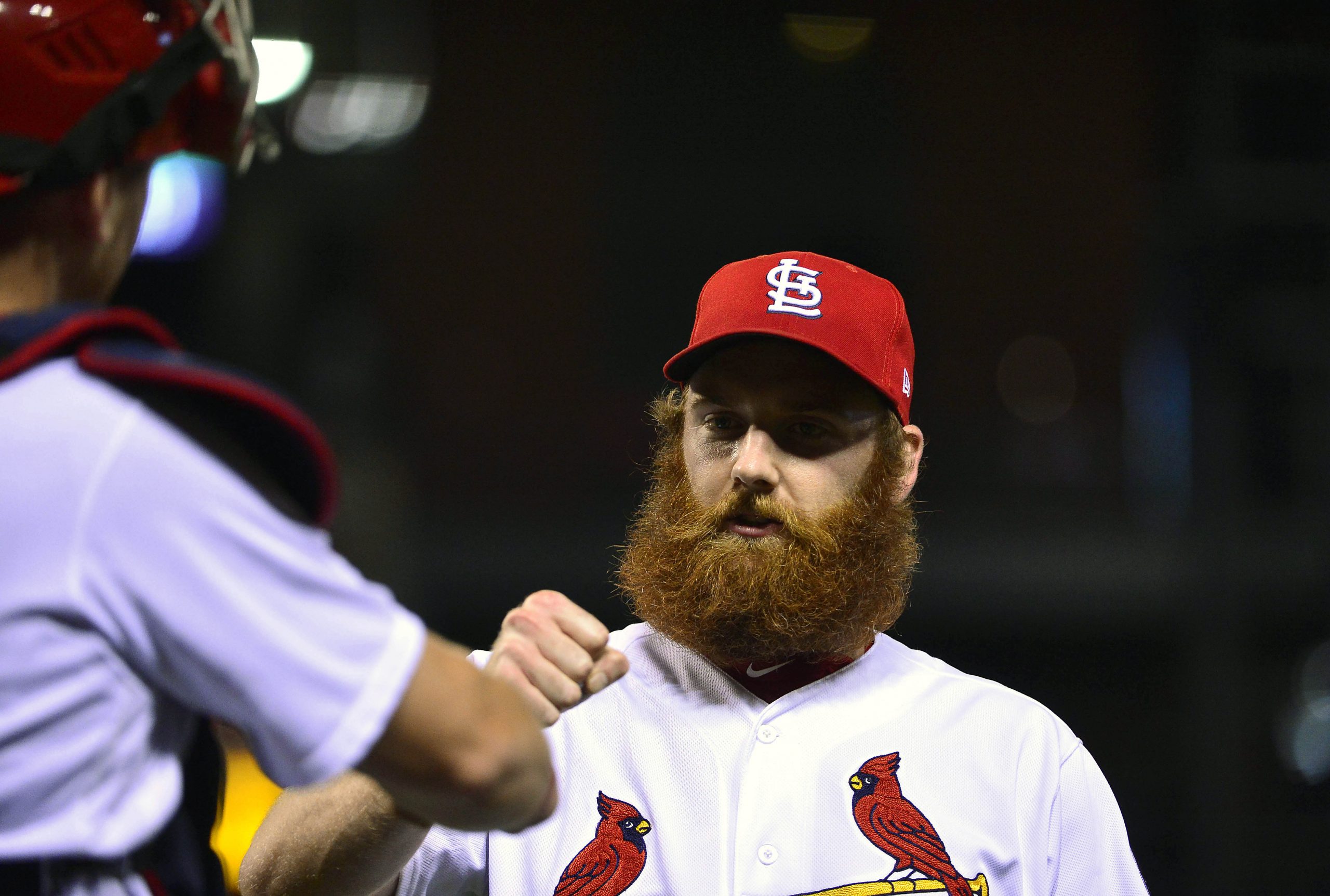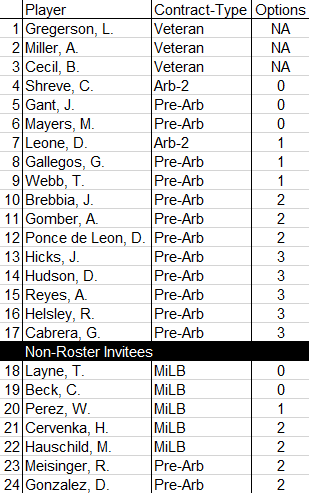Barring some kind of a star alignment that moves Craig Kimbrel‘s contract demands into the Cardinals sight-lines, I believe that the pool of relievers that the team will carry into spring training is set. I could be wrong, and there could very well be a late-January/early-February grab as low-end free agents begin accepting minor league deals. Even with those, I don’t think the Cardinals would be a particularly appealing destination. The chance of cracking the roster is just too slim.
And that’s what I’m here to talk about today. The Cardinals have a plethora or options for the bullpen — I placed 24 on my list, 17 of which are on the 40-man roster — but they do not necessarily have the flexibility to utilize the full potential of this big pool, if everyone is healthy and performing. I expressed concern about this in a November post and this serves as an extension of that post now that we have more clarity in regards to the roster. Let’s just dive into the list.
Information on Options and NRI status from Roster Resource.
Let’s start with the premise that the Cardinals will indeed carry an 8-man bullpen into 2019. This is no-longer a Matheny thing, as I explained in a post on August 3rd:
The 8-man bullpen, and subsequent 13-man pitching staff, is no longer the novelty that it was even a year ago. The advent of applied analytics, chiefly pulling starters earlier in games, has led more teams to employ an extra reliever. Currently, 12 of the 15 teams in the National League are carrying 13 pitchers. This is how a Major League roster is built in 2018.
So with that, we’ll assume the 8-man parameter.
Next there are two categories that I will use to describe the players, flexible and rigid.
“Flexible” players are very simply the ones with minor league options remaining that can be promoted and demoted at will in 2019.
“Rigid” players are those that are either on MLB Veteran contracts or are still under team control, but have had all of their minor league option years exhausted.
Brief aside: For those unsure of how options work, check out this full explanation from Fangraphs.
Flexible Relievers

I am kind of working backwards by starting with flexible players. The reason being, I want to show how many spots the Cardinals should have open to flexible relievers before I get to how many they actually have open.
So, let’s start with a couple of givens, and why I feel that way.
Jordan Hicks – Need I say more?
John Brebbia – Quietly, Brebbia was pound-for-pound the Cardinals’ best reliever in 2018. Of the 19 relievers that threw at least 10 innings for the Cardinals last year, he had the highest K%, 2nd lowest FIP, 4th highest Left-On-Base %, and the 4th lowest BB%. He fell victim to being on of the few relievers with options last season, and therefore was unfairly riding the “Memphis Shuttle” when he should have had a locked role on the big league team.
Dominic Leone – He had an odd nerve issue that kept him out for most of the season. He also gave up a few untimely HR’s in the opening weeks when the team lacked a closer. But in the end, he managed the 3rd highest K%, 2nd lowest BB%, and 2nd lowest FIP among STL RP’s. He is a very good pitcher. His 1 remaining option is handy, should he fail to pitch well, but if he is throwing as well as last year, he should not be in Memphis.
Those three should be considered locks, assuming health.
Then there is the group of: Alex Reyes, Giovanny Gallegos, Daniel Ponce de Leon, Dakota Hudson, and Austin Gomber.
All can pitch at the major league level. My personal preference is for Ponce, Hudson, and Gomber to make up 3/5 of the Memphis rotation, staying prepared to start if/when the need arises in St. Louis.
Then there’s Reyes and Gallegos.
I am a big fan of Gallegos and I documented why I am so high on him in a September post. He brings the same high strikeout/low walk profile that Brebbia and Leone offer. I would love to see him be a mainstay in the 2019 bullpen, but alas, I think he is destined to be 2019’s Brebbia, bouncing between AAA and MLB.
Reyes is Reyes. If healthy, he needs to be pitching his inning in the majors. There is plenty to debate regarding a specific role, but there is alot of sense in a semi-scheduled relief role that pitches him 2-3 innings per outing and gets him about 5 innings per week. At least in 2019, this would allow him to build his innings back up after nearly 2 full years off.
Then there is the collection of Tyler Webb, Ryan Helsley, Genesis Cabrera, and the handful of NRI pitchers with options that can be promoted as needs arise.
All-in-all, I think the Cardinals need to have AT LEAST four spots open in their bullpen for flexible relievers, if not five. Three would be filled by my “locks” and the other 1-2 would serve as a rotation of Reyes, Gallegos, the AAA starters, and Webb.
So how many do they have, right now?
rigid relievers

As we can see on the list, the Cardinals have 6 rigid relievers on the 40-man roster. If all of them are healthy and performing (unlikely) in spring training, and thus winning a spot on the team, then the bullpen is already 3/4 full, leaving just 2 spots open for the “Memphis Shuttle”.
What that means is, there is room for Hicks and Brebbia — who should be locks, anyway — and the “Shuttle” idea is dead. The remaining 9 flexible relievers on the 40-man would be on the outside, waiting for an injury.
Clearly, this doesn’t work. Especially when you consider that — other than Andrew Miller and potentially Chasen Shreve — the remaining 4 are less desirable choices than, in my opinion, 6 or 7 of the flexible options. So we have to trim 2, maybe 3, of those 6 off the roster in order to actually fill the bullpen with the most talented arms.
And that is the challenge for the Cardinals this spring.
I see a couple paths that lead to the flexible bullpen that I’m envisioning and that John Mozeliak has described over the last few years, despite not actually constructing such a setup.
Path 1: Luke Gregerson and Brett Cecil fail to bounce back.
With Gregerson, it’s really about health. If healthy, something he never was in 2018, he can be solid veteran middle reliever. Still owed $5.5M in 2019, the Cardinals likely carry him if healthy. If not, he’ll be stashed on the DL. Cecil is probably on his last chance to perform. He has a tough 2018 on and off the field. If he continues to look bad, the presence of Miller and Shreve allows them to move on.
Path 2: Everyone is healthy and pitching well.
It’s doubtful that all 6 of these pitchers are healthy and performing in Spring Training. However, if it did happen, the Cardinals would have a few marketable assets. A good, closer-to-his-Toronto-days, version of Cecil would be a really good thing, and makes Chasen Shreve expendable. A good Shreve would be an easy asset to trade. Teams always need LH relief.
Next, a good John Gant is a trade-able asset himself. I like Gant, but he is best suited as a starting pitcher, with a stable of MLB-capable SP’s sitting at AAA behind him. Conversely, he doesn’t have the electric stuff to make him a more desirable relief option than Reyes, Gallegos and company. He is very much in-between and out of options. However, as an affordable back-end rotation guy, the Cardinals should have no problem finding a home for him.
Detour: Mike Mayers is an alright reliever and the front office always seems to speak highly of him. However, I think he could get bypassed by more talented arms and end up moving in a waiver trade at the end of spring, a la Josh Lucas in 2018.
NRI’s
I’ll briefly touch on the non-roster relievers.
A few — Beck, Perez, Cervenka, and Hauschild — were picked up this winter on minor league deals. They really are more likely minor league depth and lottery tickets than anything else. Sometimes you find a gem, but don’t expect these names to be factors.
Meisinger and Gonzalez are just interesting guys to monitor.
The most interesting guy is Tommy Layne, a LH reliever that I have wrote about before. He had a really good 2018 for Memphis and has quite a bit of MLB experience. His biggest challenge is making the team from outside the 40-man, but should Cecil and Shreve both struggle in spring, he is a pitcher to keep an eye on.
Wrap-up
Getting back to the main point.
Whether it’s because of lack of health/performance or because of positional redundancy leading to trades, there are ways for the Cardinals to make 4 or 5 spots in the bullpen flexible instead of just 2.
Now, we can’t get ahead of ourselves. They need to carry all of these arms into spring and let the competition (and health) decide who is and is not needed.
But (cliche alert!) these things tend to work themselves out.
Ultimately, they need to avoid the Broxton-Tui effect, forcing themselves to keep a superior reliever (2018 Brebbia, for example) in the minor leagues because an inferior reliever at the MLB level is on a veteran contract or out-of-options.
The potential is there for a very good bullpen, it’s just a of matter whether they make room for it.
It’s high time their words on a flexible bullpen match their actions.
Thanks for reading!
Add The Sports Daily to your Google News Feed!

